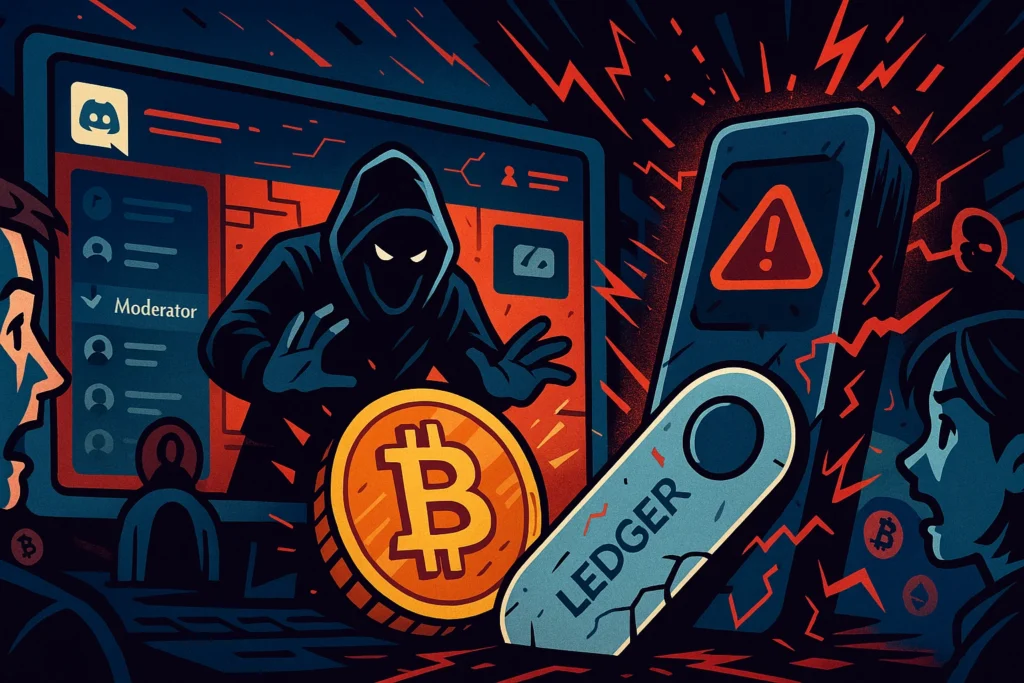The Ledger Discord Security Breach on May 11, 2025, uncovered deep flaws in crypto network safety. Attackers exploited a moderator’s Discord account to launch a targeted phishing marketing campaign, threatening users’ property and accept as true with in hardware wallet security.
They initiated the breach by way of accessing a contractor’s Discord account. Using that get right of entry to, the attacker deployed a faux bot, @Ledger_Support. It spammed the statement channel with signals about a fictional vulnerability. These messages directed customers to a cloned Ledger Live internet site that requested them to connect wallets, input recovery terms, and approve malicious firmware updates.
A lately registered domain with a Panama-primarily based privateness layer become used on this complicated rip-off. The attacker blocked alert posters, muted customers, and diverted the channel with phoney NFT giveaways in an attempt to exploit security. The phishing website used a cleverly designed mimic interface to get close to traditional browser checks.
Ledger’s institution responded quick. Within 90 minutes, they revoked the bot’s API get admission to, deleted over 230 rip-off messages, and disabled the compromised account. They also managed to stop the Ledger Discord Security Breach by restricting mentions, locking down infrastructure access, and working with Namecheap and Cloudflare to get rid of the phishing area.
Ledger carried out YubiKey 5C NFC biometric login requirements for all moderators with the intention to improve future defense. To enhance crisis security, they also scheduled red-team exercises and turned on AI-based behavioral monitoring.
Ledger Discord Security Breach Reflects Ongoing Threats
Ledger has faced previous security incidents, like the Ledger Discord Security Breach. In 2020, a records breach leaked over 270,000 consumer statistics. These leaks fueled later assaults, consisting of the April 2025 QR code phishing letters that impersonated Ledger’s headquarters.
The current phishing marketing campaign used a faux web site, ledger-live[.]app, hosted on DigitalOcean. The attacker’s drainer wallets accumulated $380,000 in ETH using a modified Angel Drainer that tricked users with EIP-712 signature popups. The wallets were later blacklisted as a result of these scams.
Ledger Discord Security Breach Spurs Industry Warnings
Binance founder CZ warned that Discord remains crypto’s weakest factor. He emphasized that users should never trust DMs after instances like the Ledger Discord Security Breach. Only 12% of crypto projects require cybersecurity certification for moderators. Discord breaches also take an average of 4.2 hours to contain, too slow for fast-moving scams. Thankfully, tools like Delink Bot now detect phishing domains using advanced pattern recognition. They also quarantine suspicious links with almost perfect accuracy.
Ledger Discord Security exposes breach users
Despite the assurance of laser without any internal agreement, many users were damaged by the Ledger Discord Security Breach. Analysts confirmed 14 dried ethereum wallets, 3 solana losses, and more than 1.4 BTC theft. The laser urged the affected users to revive the seed phrases, take the property offline, and enable “transactions firewalls” to block malicious contracts.
Conclusion
The Ledger Discord Security Breach is a powerful reminder: the weak points of crypto often lie on the human layer. Hardware wallet manufacturers should go beyond technology-training, monitoring, and web 3-root communications are now mandatory. In Crypto, every click matters, and every scam begins with confidence.
